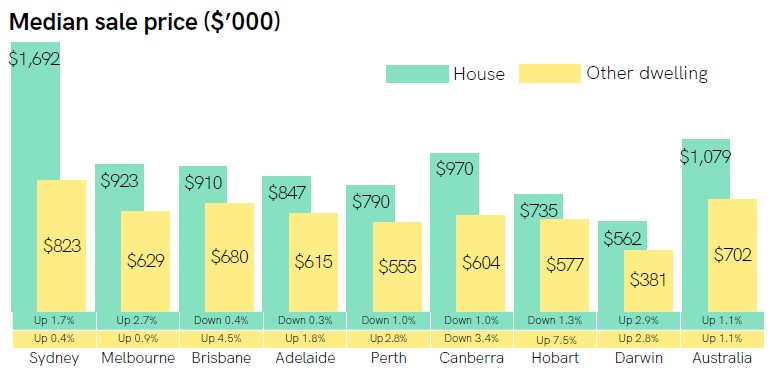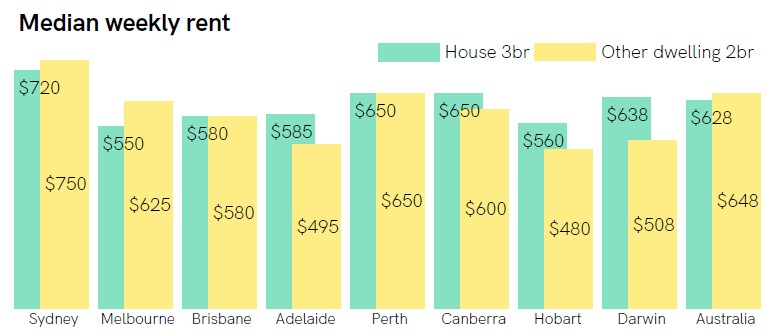'Other dwellings' led Perth's sale price growth in the March 2025 quarter, according to the latest Real Estate Institute of Australia (REIA) Real Estate Market Facts.
The median sale price for other dwellings, which includes home units, townhouses, flats/apartments and terrace homes, increased 2.8 per cent over the quarter and 19.4 per cent over the year to $555,000.
REIWA President Suzanne Brown said the strong growth wasn't surprising.
"Significant growth in house prices over the past couple of years has seen people seek more affordable alternatives when looking to buy a home," she said.
"Other dwellings are generally more affordable than houses, especially in areas close to the CBD and key lifestyle attractions, and demand for these types of homes has increased, putting strong upward pressure on prices.
"However, despite the increase over the past year, Perth remains one of the most affordable capital cities for other dwellings, with only Darwin recording a lower median sale price."
The median house sale price declined 1.0 per cent over the March quarter to $790,000. This was 14.5 per cent higher than the same time last year.
Ms Brown warned the decrease shouldn't be taken as a sign the market was moving into a downturn.
"A review of that data shows that at the start of the quarter there was a large drop in house sales in higher price brackets, particularly in the million dollar plus bracket. This change in activity can see the overall median decline," she said.
"The conditions underpinning price growth persist, with our population still growing strongly and relatively low new home completions, so we can expect the Perth median price to increase over the remainder of the year.
"However, the rate of price growth for houses is slowing and some suburbs, particularly those at the higher end of the market, are starting to record price stability or small declines.
"If you are selling or buying it's important to discuss market conditions with a local REIWA agent."
In the three months to March, the median sale price for other dwellings increased in all capital cities except Canberra, which recorded a decline. Median house sale prices rose in Sydney, Melbourne and Darwin, but fell in all other capital cities.

Source: Real Estate Institute of Australia (REIA).
Median other dwelling sale prices: Perth and regional centres
Median sale prices for other dwellings rose in all metropolitan areas in the March quarter: Perth Middle (up 3.6 per cent to $570,000), Perth Inner (up 3.3 per cent to $599,000) and Perth Outer (up 2.0 per cent to $489,500).
They also rose across the regions: Broome (up 11.9 per cent to $464,500), Albany (up 8.8 per cent to $413,500) and Bunbury (up 3.7 per cent to $425,000).
Annually, the median sale price rose in Perth Middle (up 23.9 per cent), Perth Outer (up 18.0 per cent) and Perth Inner (14.1 per cent).
Very strong price growth was seen in Albany (up 45.1 per cent) and Bunbury (up 30.8 per cent), while the median sale price in Broome increased 16.5 per cent.
Median house sale prices: Perth and regional centres
The median sale price for houses increased in Perth Outer (up 0.8 per cent to $741,000) but decreased in Perth Middle (down 2.7 per cent to $914,500) and Perth Inner (down 12.7 per cent to $1,460,000).
In the regions, prices rose in Albany (up 3.6 per cent to $650,000) and Bunbury (up 3.6 per cent to $645,000) but declined in Broome (down 2.2 per cent to $792,500).
Annually, the median house sale price increased in Perth Outer (up 14.0 per cent) and Perth Middle (up 13.6 per cent) but decreased in Perth Inner (down 4.3 per cent).
All the regional centres recorded increases over the year: Bunbury (up 19.4 per cent), Albany (up 18.7 per cent) and Broome (up 13.8 per cent).
Rental market
Median weekly rent
The median weekly rent price for two-bedroom other dwellings rose 4.8 per cent over the quarter to $650, reaching parity with three-bedroom houses.
Annually, the median rent for two-bedroom other dwellings increased 8.3 per cent.
The median rent price for three-bedroom houses was $650 per week in the March quarter. This was unchanged from the December 2024 quarter, but was 8.3 per cent higher than the same time last year.
Ms Brown said the Perth rental market continued to record periods of stability, interspersed with small movements in median prices.
"The rate of rent price growth has slowed, which reflects the changed conditions in the rental market over the past year," she said.
"New supply has been coming to the market, which has seen the vacancy rate increase from a record low of 0.4 per cent at the end of March 2024 to 2.5 per cent at the end of March 2025.
"However, as with the sales market, conditions vary from suburb to suburb. There are some suburbs, such as those closer to the CBD or popular lifestyle hubs, where competition for rental properties remains high and the vacancy rate is under 1 per cent. In these areas, the upward pressure on rent prices remains strong.
"Price pressure is generally lower in those suburbs where a lot of investor-owned new builds have come to the market. Here supply may outweigh demand and investors may need to reduce their asking price to secure a tenant."
Over the three months to March, the median weekly rent for two-bedroom other dwellings rose in all capital cities except Sydney, where it remained stable. The median weekly rent for three-bedroom houses increased in Brisbane, Darwin, Hobart and Adelaide, and remained stable in Sydney, Melbourne and Canberra.

Source: Real Estate Institute of Australia (REIA).
Median two-other dwelling rent prices: Perth and regional centres
Median weekly rent prices for two-bedroom other dwellings rose across all metropolitan areas: Perth Inner (up 6.1 per cent to $700), Perth Outer (up 3.6 per cent to $570) and Perth Middle (up 3.2 per cent to $650).
There were mixed results across the regions: Broome (up 21.0 per cent to $750 per week) and Bunbury (up 4.3 per cent to $480 per week) recorded increases, while the median weekly rent declined in Albany (down 2.3 per cent to $430).
Over the year, all Perth metropolitan areas saw an increase in median weekly rents: Perth Middle (up 12.1 per cent), Perth Inner (up 12.0 per cent) and Perth Outer (up 11.8 per cent).
The mixed results in the regions continued over the year: increasing in Albany (up 11.0 per cent) and Bunbury (up 4.3 per cent) but declining in Broome (down 9.1 per cent).
Median three-bedroom house rent prices: Perth and regional centres
Median weekly rent prices for three-bedroom houses rose in Perth Middle (up 3.4 per cent to $750), while they remained stable in Perth Inner ($850) and Perth Outer ($650).
Across the regions, rent prices increased in Broome (up 5.0 per cent to $1,050 per week), but remained stable in Bunbury ($600 per week) and Albany ($550 per week).
In the 12 months to March, median weekly rent prices increased in all metropolitan areas: Perth Middle (up 7.9 per cent), Perth Inner (up 6.3 per cent) and Perth Outer (up 4.8 per cent).
Across the regions, Albany recorded growth (up 10.0 per cent), prices remained stable in Bunbury, and declined in Broome (down 8.7 per cent).
Vacancy rate
Perth's rental vacancy rate rose to 2.5 per cent at the end of the March quarter. This was a 0.6 percentage point increase on the December quarter and 2.1 percentage points higher than a year ago.
Ms Brown said while 2.5 per cent was considered the lower end of a balanced market, reaching this milestone did not mean the challenges of the past few years would suddenly disappear.
"WA is still recording strong population growth, although not as strong as previous years, and the estimated number of rentals remains about 5 per cent below the peak recorded in February 2021," she said.
"These factors are maintaining pressure on the rental market as a whole. There will still be some increases in Perth rent prices in the months ahead and challenges finding rental properties, depending on where you are looking."
Over the quarter, vacancy rates also increased in Sydney and Melbourne, remained stable in Hobart, and declined in Brisbane, Adelaide, Canberra and Darwin.

Source: Real Estate Institute of Australia (REIA).






